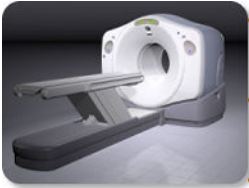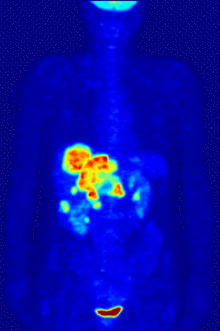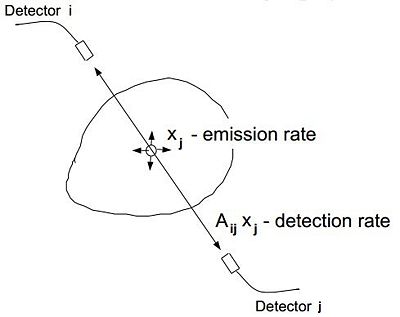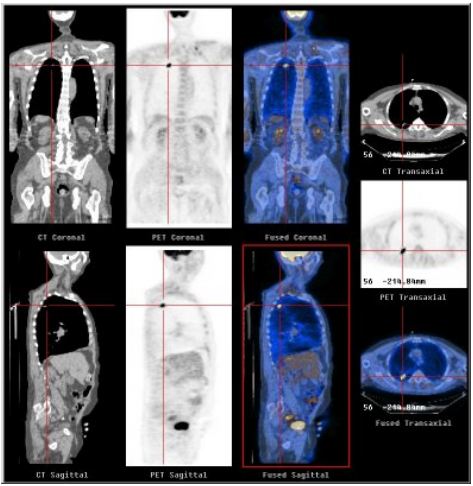The Bouman Lectures on Image Processing
A sLecture by Maliha Hossain
Subtopic 3: Positron Emission Tomography
© 2013
Excerpt from Prof. Bouman's Lecture
Accompanying Lecture Notes
Positron Emission Tomography, or PET, is a non invasive imaging technique that produces a three-dimensional representation of the body. It is commonly used in clinical oncology and is a functional medical imaging modality. It can also be used as a form of molecular imaging.
Figure 1 shows a PET scanner. It is very similar to a CT scanner in appearance but the process in which measurements are taken by a PET scanner is completely different.
Description of how PET works.
they inject you with a radiotracer. a radioactive tracer tupically FDG (fluorine deoxy glucose). a sugar with a fluorine atom attached. but this fuorine is F-18, a radioactive isotope of Fl. half life of about ... this is long enough for it to be produced in a cyclotron and combined with the sugar and transported to the hospital and be detectable after the sugar has been injected (is the chemistry of a nuclear isotope the same?) the body metabolzes this as sugar. Cancerous cells tend to metabolize more sugar because they tend to grow at a fast rate. the tumour will have a higher rate of uptake of the FDG than the surrounding sugar and it will light up in the scan. your bladder and your kidneys will also light up since they process sugar to excrete it?
"The system detects pairs of gamma rays emitted indirectly by a positron-emitting radionuclide (tracer), which is introduced into the body on a biologically active molecule. "
FDG and fluorine isotope
- Subject is injected with radioactive tracer
- metabolism of sugar. chemistry
- Gamma rays travel in opposite directions
- When two detectors detect a photon simultaneously, we know that an event has occurred along the line connecting detectors.
- A ring of detectors can be used to measure all angles and displacements
obtain line integral/projection for CBP
the FDG in the patients body is metabolized, the FDG may break down but the F (ion?) is still radioactive. so the nuclues is unstable. when it breaks down, simplified, it releases a positron which annihilates a nearby electron. As a result of this annihilation, two gamma particles are released. the momentum of the two gamma particles are not exatly zero because the positron had some momentum before it collided with the electron. the angle is approximately 179 degrees. so you have two gamma particles travelling at almost exactly opposite directions. the PET contains a ring of detectors (this ring is stationary whereas the detectors in a CT scanner rotate with the gantry). Each detector in a PET scanner counts photons. when it encounters photon. it registers the time of the photon. a photon travels about a foot (30 cm to be exact) in free space in a ns. if two detectors that are across from each other detect a scintillation within at the same time or very close to each other (within a small margin of time) it is assumed that those two photons were produced from the same annihilation.
figure for positron electron annihilation
$ E[y_i] = \sum_j A_{ij}x_j \ $
PET scanners are much more expensive than CT scanners. They also have poor spatial and temporal resolution. Most PET systems are equipped with a CT scanner like the one shown in figure 1. Figure 4 shows a PET scan superimposed on a CT scan. This is much more helpful to radiologists trying to diagnose diseases. You can see that there is very little anatomical detail in the stand alone PET scans in figures 2 and 4.





